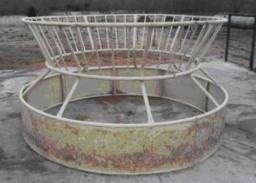By Garth Ruff
Now that we have had nearly a week of hard frost, the end of the grazing season is in sight. Previous authors of this column have talked about having a plan for feeding hay in terms of how long and when to start. This week let’s look at different approaches to winter feeding and the pros and cons of each system.

Bale feeders with tapered cone design have proven to be “hay savers.” Photo: Oklahoma State University
Feeding hay is expensive, if you waste it, you lose money. Consider the following to minimize waste during feeding.
- Feed hay in a feeder to minimize waste. Feeding hay in a feeder or ring reduces the amount of feed trampled and soiled, especially when feeding large round bales that provide several days of feed.
- Feed hay in well-drained areas. If you intend to feed hay in a single location all winter, consider feeding on crushed gravel or even concrete pad can help minimize problems with mud. If feeding on a pad, manure management is another part of the equation.
Large round bales with ring: A better system for feeding large round bales is to set the bale in the pasture or feeding area but limit access to the hay with a feeder or hay ring. This system requires an initial investment in hay feeder or rings, but feeding losses are lower. Feeding hay in racks or rings is crucial for producers who do not or cannot feed hay to their cattle daily.
Consider bale feeders with tapered cone design as another option. These “hay savers” come in a variety of makes and models but the general design has been tested with regards to winter feeding.
Data from a three-year study at North Dakota State University, looking at mature third trimester cows used an economic analysis model with budgets for 100- and 300-cow reference herds and determined that feeding in a tapered cone round bale feeder versus unrolling bales or grinding hay and feeding on the ground led to the following:
- significantly increased cow weight gain;
- resulted in greater positive rib fat depth change;
- reduced hay consumption an average of 10.2%; and
- reduced hay waste in the two years of the study when alfalfa-grass hay was fed, but not in the year when oat hay was fed.
Unrolling large round bales: Another popular system is to unroll the bale and feed it on the ground as loose hay. When fed daily, feeding losses run about 12 percent. In Eastern Ohio this method is often used during calving season to provide laying area for young calves, in this instance expect greater feeding losses.
Processing or grinding hay: Grinding or chopping hay can reduce waste, sorting, and refusal of long-stemmed hay. Processing also allows for the inclusion of lower quality, less palatable hay in total mixed rations. Processed hay is best when fed in a bunk of some sort. One must evaluate the equipment cost of a bale grinder or processor.
Summary: Research from NDSU showed that feeding round bales in a tapered-cone feeder reduced wintering cost by 21% for the 100-cow herd and 17.6% for the 300-cow reference herd compared to feeding processed bales. Rolling out round bales was in between in cost (Landblom et al. 2005 NDSU Cattle and Range Research Report).
No matter what, some hay will be lost or wasted, and mud will be ever a present challenge. Proper feeding management minimizes these losses. Since hay is often the most expensive feed used on beef operations, there is incentive to minimize waste via implementing management practices.
Source : osu.edu